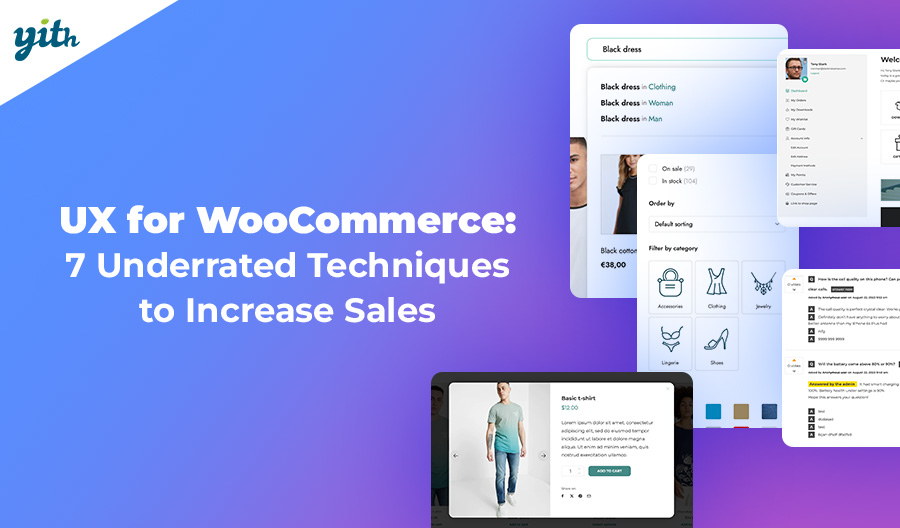The world of online sales has existed for many years, but only recently has there been a true competition in this digital gold mine. More and more businesses are discovering the need to improve their online presence, entering a massive yet highly competitive market.
Indeed, while an online store can open the doors of your business to the entire world, it also means setting up shop on a street where millions of stores already exist. That’s why it’s not enough to simply launch your website and hope for the best, you need to make every possible move to maximize your site’s potential.
This is where eCommerce digital marketing comes in, a form of marketing with its own rules, vastly different from traditional marketing.
In this article, we’ll explore how to navigate this Competitive Digital Market, how to strengthen your eCommerce store, and what strategies to adopt to fully leverage digital marketing in promoting your products.
To achieve this, we’ll use WordPress and WooCommerce as our CMS (Content Management System)—two free, highly flexible tools that allow you to customize your online store exactly as you envision it.
Let’s get started!
Table of contents
- Optimizing Your WooCommerce Store for Marketing Success
- Attracting Organic Traffic: Mastering SEO for Your WooCommerce Store
- Fueling Engagement and Authority: Strategic Content Marketing for eCommerce
- Accelerating Growth: Targeted PPC Advertising for WooCommerce
- Building Your Tribe: Engaging Social Media Marketing Strategies
- Maximizing Customer Lifetime Value: Effective Email Marketing for WooCommerce
- Expanding Your Horizons: Affiliate & Influencer Marketing for eCommerce
- Data-Driven Decisions: Analytics, Testing, and Conversion Rate Optimization (CRO)
- How YITH Plugins Can Be Your Power-Up for Digital Marketing
- Conclusion: Mapping the Path for Continuous eCommerce Growth
Optimizing Your WooCommerce Store for Marketing Success
Optimizing your website can be a long process, but not necessarily complicated. Keep in mind you will need to repeat it regularly to keep up with trends, so it is advisable to break it down into easy-to-follow steps, as follows.
Provide an Easy and Intuitive Navigation
Compared to a physical store, an online store can be more difficult to navigate. There are no aisles or sales assistants ready to help customers, so it is important to offer a clear path and easy-to-understand methods.
An average user spends about 45 seconds on a website before leaving, with an average visit duration of around 2 minutes for an eCommerce site. Clearly, making a sale within this time frame can be very challenging, so you must take all possible steps to increase the time users spend on your site.
To do this, you need to identify the reasons why users leave your site without buying anything.
Excluding organic abandonment, which is normal in any business, high cart abandonment rates are often caused by hostile and complicated navigation. Even a small issue, such as slow-loading pages, can lead to very high abandonment rates, resulting in the loss of many potential sales.
Here are some measures you can take to improve this aspect of your site:
- Loading speed – A fundamental aspect, as mentioned, is related to the loading speed of the page. The days when people were willing to wait a full minute to see a web page are over—today, even a delay of a couple of seconds can cost you half of your sales. For this reason, make sure to use a high-quality hosting service and avoid heavy images that could slow down the page loading time. Choose lightweight formats optimized for the web, such as .webP.
- Mobile navigation – More and more people are now using their smartphones to browse online, so your site must be perfectly accessible on a small screen and have vertically structured pages. In this regard, ensure that you use a mobile-friendly theme like Wonder.
- Simplify checkout – One of the most critical steps in the purchasing process is the checkout. When facing a payment, doubts may arise for customers, potentially affecting your conversion rate. Industry leaders like Amazon introduced one-click checkout to reduce this friction as much as possible. Even if you don’t implement this exact feature, simplifying the checkout process by requesting only essential information for the sale can significantly decrease abandonment rates on your site since most users dislike providing unnecessary personal information.
- An appealing store – Choose images that grab the customer’s attention while they browse your store. The last thing you want is for users to perceive your catalog as a dull wall and lose interest. Customer testimonials and reviews, a memorable logo, and a well-crafted brand identity that conveys a promise of quality and value can significantly help engage visitors.
- Make the catalog easy to browse – When it comes to your store, a key aspect of eCommerce marketing is helping customers find the product they’re looking for effortlessly. One useful tool for this is YITH WooCommerce Ajax Product Filter, which introduces attribute-based filters into your catalog, using images and Ajax technology to update the displayed products in real time based on the customer’s selection.

Taking the visual aspect used by portals like Amazon, Ajax Product Filter makes navigation on your site more familiar and intuitive, increasing sales and dwell time on your site.
Attracting Organic Traffic: Mastering SEO for Your WooCommerce Store
The acronym SEO (Search Engine Optimization) has surely appeared multiple times during your research, given how important it is for any online business. SEO encompasses all the strategies needed to improve your site’s ranking in search engine results pages.
A better ranking in search engines (especially among the top results on Google) can make the difference between a few dozen visits per month and hundreds of thousands, leading to a huge impact on sales thanks to organic user traffic.
Mastering SEO is a major challenge, so if your budget allows it, it is generally recommended to hire an expert who can analyze and update your site whenever necessary. Search engine parameters change over time, and even a perfectly optimized site may no longer be fully effective after a few years.
Nevertheless, here are some key SEO strategies to pay attention to for your website:
- Use keywords – These are the words that appear most frequently in users’ searches and should therefore be integrated into your site, product pages, and more.
- Pay attention to all text – It’s not just long blocks of text, like those on the homepage or blog articles, that matter for SEO. Even shorter lines are crucial, such as product titles and descriptions, and even the names of the images you upload to product pages.
- Improve readability – Make your website easy to read by using appropriate heading tags, such as H1, H2, H3, and so on. Creating a hierarchical structure within your pages can help both increase user engagement and boost SEO.
- Include a blog – Publishing high-quality, informative articles associated with your products and services can greatly enhance search engine indexing for your website.
- Run tests – Don’t be afraid to experiment: keep track of page analytics, try different product page layouts, and analyze the results to find the most effective system for your website and audience.
Fueling Engagement and Authority: Strategic Content Marketing for eCommerce
As mentioned earlier, content creation, such as maintaining a blog, can be a powerful driver for your eCommerce business. A significant portion of effective marketing revolves around this factor.
Of course, this doesn’t mean simply creating random content for the sake of it. A thorough analysis is essential before creating content, and it is important to determine how to spread it online.
More Than Just a Blog: How Content Marketing Builds Trust and Drives Sales
The first step, therefore, is to understand your audience in terms of age, gender, and geographic distribution, but also their interests, language, and needs.
A valuable shift in perspective is to stop thinking like a seller whose sole objective is to sell a product. This is because customers don’t think like buyers. They don’t begin their searches with the mindset of spending money or purchasing something without a reason.
Most searches stem from a need. When your potential customers conduct an online search, they are expressing a need that your products or services should fulfill.
Let’s take a concrete example: you sell insect repellent, because of this, you might be tempted to write articles about how your product is the best solution—what ingredients it contains, what types of insects it repels, how long the application lasts, usage tips, and much more.
While all these details are indeed valuable for your customers, remember that people don’t typically search for phrases like “Which product contains these substances?” or “Application of product X against wasps.”
Instead, it’s far more likely to see them search “Wasps on the balcony,” “Cockroach extermination,” or “Keeping ants away.”
You need to step into your customers’ shoes and understand what prompts their searches so that you can provide a direct and clear answer with both your articles and your product pages.
You also need to ensure high-quality content. With so many blogs online, many users have grown tired of articles that blatantly exist only to sell a product. They often feel too much like traditional advertisements to be truly effective.
Another highly effective way to engage customers is through storytelling. Incorporating testimonials or telling a story, even a fictional one that feels authentic, where a specific problem is resolved through the use of your products or services is a great marketing technique.
Developing Your Content Marketing Plan for WooCommerce
Once you have allocated time and budget to content creation, it is important to develop a Content Marketing strategy. Here are some key points to keep in mind:
- Set up an editorial calendar – Ideally, you should maintain a consistent publishing schedule, so determine how much content you can produce continuously over the long term.
- Leverage social media marketing – Engage content creators, share your articles on your social platforms, and analyze which channels are most popular among your audience. Different businesses may achieve varying results from the same social media platforms.
- Prepare various formats – The same content can be delivered as an article, a short post on social media platforms, a video on YouTube, and much more.
- Avoid using AI – While quickly generating multiple pieces of content may seem tempting for a seller, AI-generated content is mostly inaccurate and much less effective than human-written content. Keep AI just as an assisting tool for gathering ideas and structuring articles.
It may take a while to see results, so keep on experimenting. Digital Content Marketing can take months to show its first impact, but it is an investment worth making.
Accelerating Growth: Targeted PPC Advertising for WooCommerce
If your budget allows it, consider paid advertising such as PPC (Pay Per Click) to display your website on search engines and social media.
To maximize effectiveness, identify the most suitable platform for your digital advertising campaign. This could be Google Ads, Facebook, Instagram, TikTok, YouTube, or others. Knowing your target audience will help pinpoint the best platform.
Use keywords strategically in your ads, and ensure your landing pages are optimized for the right target customers to immediately capture their attention when they first visit your site.
Tracking the performance of your targeted ads campaign is crucial in determining its success. Analyzing results will allow you to make adjustments and improvements for future campaigns.
Building Your Tribe: Engaging Social Media Marketing Strategies
Your goal is to create a community to leverage user-generated content. Beyond selecting the right channels, it’s crucial to define the message you want to convey. Content should be engaging to foster genuine interaction.
Among user-generated content, the most powerful are reviews or unboxing videos.
Your product shouldn’t just focus on selling, it should provide value and strongly address a need.
When creating content, keep the end goal in mind: sales, brand value enhancement, organic traffic growth, informative content, and more.
Maximizing Customer Lifetime Value: Effective Email Marketing for WooCommerce
While attracting potential customers is essential, retaining existing ones is even more important. Customer loyalty is often underestimated, yet it plays a crucial role in revenue.
A powerful way to maintain loyal customers is email communication. You can create an email funnel that reaches customers based on different triggers, such as a welcome email, cart recovery reminders, or special occasion discounts (like birthdays) to re-engage dormant customers.
Although many people prefer instant messaging platforms like WhatsApp and Telegram, don’t overlook the professionalism and reliability of email marketing campaigns.
Additionally, newsletters remain a timeless tool to attract customers due to their proven effectiveness.
Expanding Your Horizons: Affiliate & Influencer Marketing for eCommerce
Affiliate marketing is becoming increasingly popular, with many individuals making it their primary (or even sole) source of income.
Offer your customers the opportunity to promote your products in exchange for a commission on sales, provide targeted and personalized incentives, and extend this option to influencers with large and highly engaged communities to encourage them to promote your products on your behalf.
If you’re using WordPress and WooCommerce as the foundation for your eCommerce store, consider the YITH WooCommerce Affiliates plugin, which allows you to set up an affiliate system on your site with just a few clicks.
Data-Driven Decisions: Analytics, Testing, and Conversion Rate Optimization (CRO)
Once again, it is essential to monitor your website statistics to identify any issues affecting your sales process and measure the results of your marketing campaigns.
Use Google Analytics to analyze user navigation and identify where visitors drop off. Test different techniques on various pages, and don’t be afraid to experiment; over time, all your efforts will pay off.
How YITH Plugins Can Be Your Power-Up for Digital Marketing
WordPress and WooCommerce provide a highly flexible and powerful foundation, but the only way to fully harness this potential is by integrating plugins that enhance existing features and introduce new ones.
YITH offers a vast catalog of plugins that are fully compatible and perfectly integrated with each other, allowing you to customize your site as you wish.
With just a click, you can incorporate popular features from successful platforms like Amazon. These include product filtering, wishlists to share with friends and family, abandoned cart recovery emails, recommended products to purchase together, and more.
Explore the plugin catalog and find out how to maximize the potential of your eCommerce store.
Conclusion: Mapping the Path for Continuous eCommerce Growth
Growing an eCommerce space in today’s digital world requires strategy, consistency, and a well-defined overall vision.
As we have seen, simply having an eCommerce store is not enough. You need an optimized website, a solid search engine optimization (SEO) strategy, engaging content, targeted advertising campaigns, and effective tools to build customer loyalty.
The combination of WordPress and WooCommerce along with the right plugins, such as those offered by YITH, provides a powerful and flexible foundation for creating a truly competitive online store.
However, the real key to success is an integrated approach. Every decision should be data-driven, tested over time, and continuously improved. A sucessful eCommerce marketing strategy is not a shortcut but a structured path toward sustainable growth. With the right skills and tools, you can not only survive in the digital market but truly make your eCommerce business take off.



